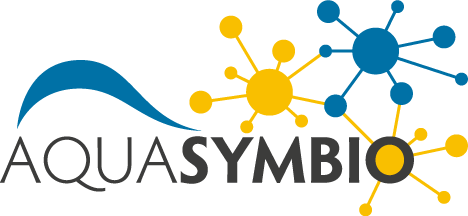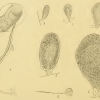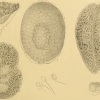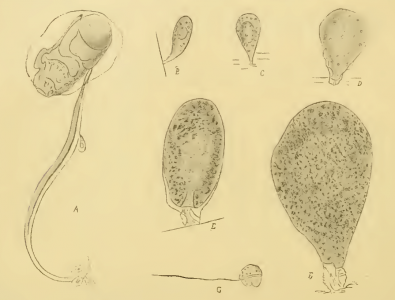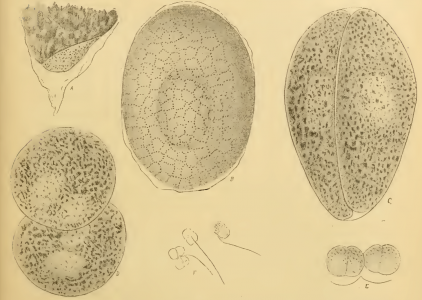Oodinium poucheti
Diagnosis
Diagnosis_Genus: Oodinium Chatton 1912. External parasite of tunicates, chaetognaths and possibly polychaetes. The trophont is sac-like and is attached to the host by a stout peduncle with a very large, flat attachment surface closely adhering to but not penetrating into the epithelial cells of the hosts. The cell membrane of the attachment surface has numerous thin and long invaginations serving for increased absorption of the nutrients by osmotrophy. There are no chloroplasts, the trophont's theca has plates filling its alveoli and constituting together the dinoflagellate armour of the cell. There are no starch grains. The nucleus contains stout coiled chromosomes only in young individuals. The dinospore is a gymnospore. (Lom 1981).
Diagnosis_Species: Oodinium poucheti Lemmerman 1899. Parasite of Oikopleura. The trophont is attached to the tail. Young tropont are pyriform (20 x 10 µm), attached to the host tail by their tips. This is a hyalin cell that turns brown during maturation. The parasite is attached by a colourless robust peduncule, ending by a disc on the host tegument, that extends inside the host cytoplasm. This peduncule is covered by the external cuticule of the parasite. The sporocyte (170-180 µm long, 100 µm wide) is released and become spherical. Cleavage of the sporocyte is longitudinal. A new mitotic division starts before the release of the two daughter cells from the precedent division, meaning that these sporocytes are always binucleated. Daughter cells are released from the mother cuticule, and produce a new one. Volume of the parasite decreased following successive divisions to reach about 11 µm or less. Sporogenesis takes 24 hours.
Body_trophont_length: 170-180 µm
Body_trophont_wide: 100 µm
Body_spores: <11 µm
Pigment: No
Etymology
In honor to the Pr Pouchet, who was the first to describe this parasite as Gymnodinium pulvisculus in 1885.
Type species
This is the type species of the genus.
Type illustration / Type locality / Type specimen
Type Host: Oikopleura sp.
Type locality: Concarneau
Ecology
Substrate: epizoic
Sociability_trophont: gregarious
Salinity: marine
Life cycle
Generation: <1 month
Symbiont: horizontal
Reproduction_mode: asexual
Feeding behaviour
Mode of locomotion
Attached phylogeny
Observation site(s)
Observation site(s)
HOSTS
SYMBIONTS
| Association with... | Region origin | Name of site | In reference... |
|---|---|---|---|
| Amoebophrya grassei | Alger Bay | , “Contribution à l’étude des péridiniens parasites. Cytologie, cycles évolutifs.”, Ann. Sci. Nat. Zool., vol. 6, pp. 1-158, 1964. |






